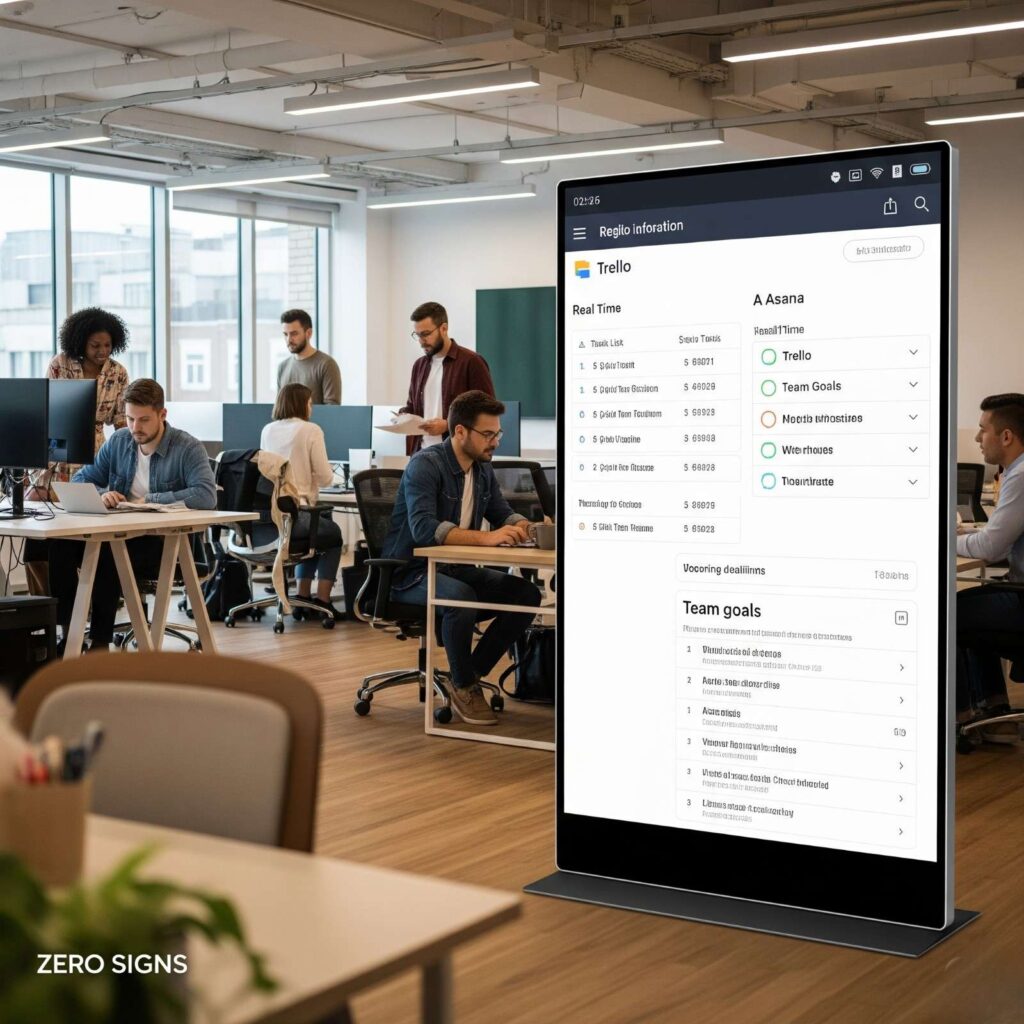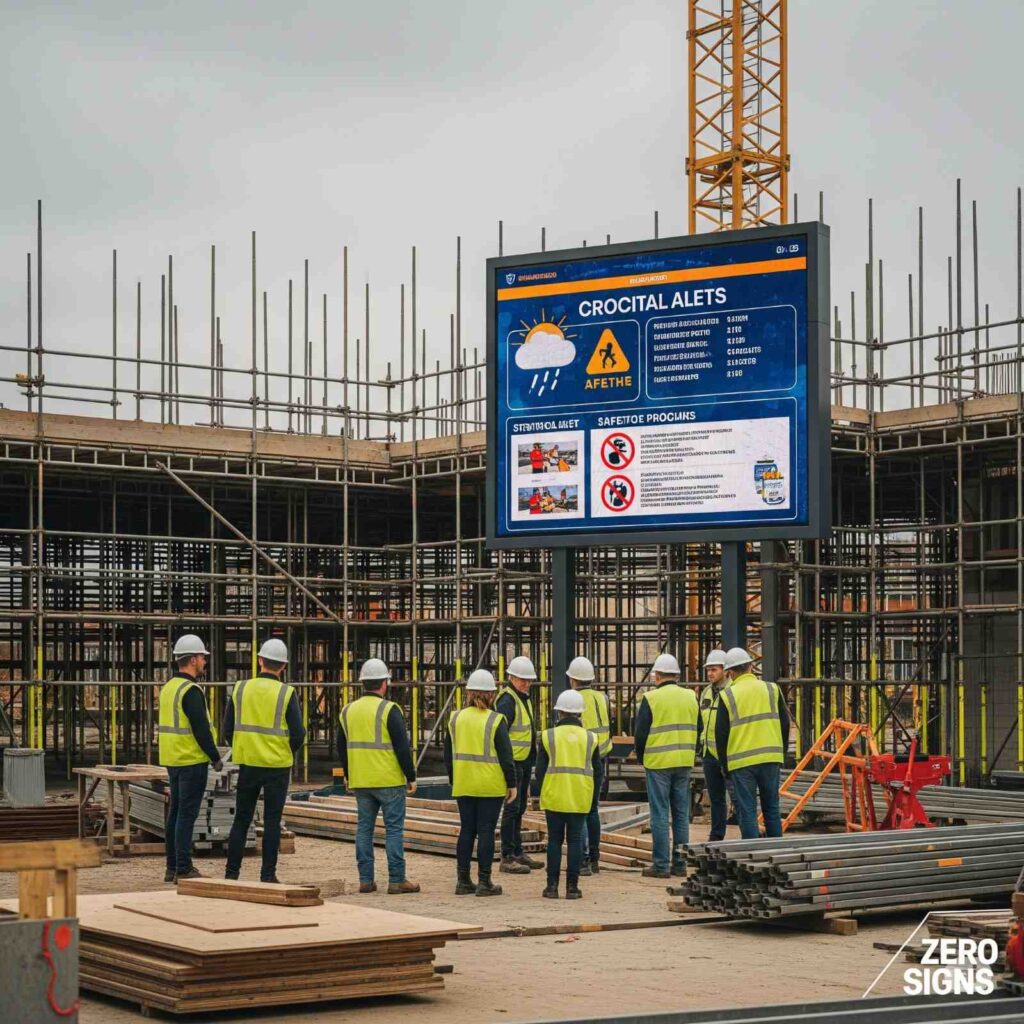Walk into a busy office or worksite, and you might notice something new on the wall. Instead of posters or paper charts, you’ll see bright digital screens showing live updates. They are not playing ads or news, they are sharing project goals, schedules, and task lists. This is not just a trend or a tech gimmick, it’s a powerful new project tool. In many workspaces today, especially across Cheshire, screens have become part of daily planning. Whether it’s a retail shop, office, or construction site, these screens support better teamwork. The shift is simple. Teams now use digital signage management to show what matters most. Instead of logging into multiple apps, teams see real-time data as they walk by.
And why is this important? A 2024 study by Grand View Research provides the answer. It shows the digital signage market could grow to $45.3 billion by 2030 globally. The increase is driven by high demand from offices, shops, and industrial workplaces. Let’s now explore how does digital signage enhance project management in your business.
What Is Digital Signage and How It Works in Projects Management
To use this tool well, you must first understand what is digital signage clearly. It is a display screen that shows dynamic content in real time. These screens come in different forms; TVs, LED panels, or even small dashboard monitors. Each one connects to software that controls what appears and when it updates.
In project settings, this tool plays a key role in keeping teams aligned. It brings all important project data into one shared visual space. Here’s what this signage shows in a project environment:
- Daily schedules, work targets, or team progress
- Live alerts, task updates, and missed deadlines
- KPIs, charts, graphs, and milestone achievements
- Updates pulled directly from apps like Trello, Asana, or Monday.com
This real-time display builds unity because all team members see the same project status. No one needs to guess what’s next or check five different platforms for updates. In short, digital screens become the team’s single source of truth every day.

How Digital Signage Improves Team Communication
Communication problems slow down most projects, even when teams are experienced and skilled. Emails get missed, messages are delayed, and meetings eat up valuable work hours. Using this signage type, you can avoid these common problems quickly and easily.
When teams see shared screens, they don’t rely on verbal updates or lengthy reports. Here’s how signage supports faster, clearer team communication every day:
- Shares meeting times, key notes, and task reminders in open spaces
- Shows live dashboards and updates that everyone can access in real time
- Prevents duplication of work by showing team-wide progress and blockers
- Builds transparency across teams, departments, and even remote work locations
Forrester Research found visual communication boosts decision-making speed by 34% on average. This is why so many workplaces now use signage to speed up internal communication. Less talk. More action. That’s the power of digital communication done right.
How Real-Time Updates Help Keep Your Project on Schedule
Every project depends on time. One missed task can affect an entire workflow chain. Real-time updates are critical if you want to meet deadlines and reduce costly delays. So, how does digital signage enhance project management from a timing perspective? It brings instant feedback directly to the team’s eyes, no logging in or waiting. Using screens for real-time tracking helps teams in many practical ways:
- Shows if a task is done, delayed, or stuck at any given moment
- Displays alerts so issues get solved quickly before they grow worse
- Sets department-specific displays to show different data in different locations
- Replaces outdated whiteboards with fresh updates pulled from trusted sources
According to McKinsey & Co., tracking real-time project data improves delivery by up to 25%. That means fewer surprises and better planning for project managers and teams alike. When everyone sees the live updates, they move faster and with more purpose.
Real Examples of Digital Signage Used in Project Management
This strategy works across industries and business types. It’s not just for large tech firms. Small teams in Cheshire now use signage to stay on track with minimal resources. Here are a few real-life examples of where such signage is making an impact:
Construction Sites
- Weather alerts, safety updates, and progress summaries are displayed for site workers
- Teams stay informed of delivery delays, hazards, or permit issues in real time
IT and Tech Teams
- Sprint boards, ticket statuses, and server health data are shown on team dashboards
- Helps reduce email chains and improves DevOps response time during system alerts
Corporate Offices
- Digital signs show company goals, countdowns, and team performance in shared areas
- Keeps everyone; from admin staff to managers, informed and engaged every day
Logistics and Warehouses
- Displays delivery times, stock levels, and order tracking in real time
- Reduces confusion and speeds up warehouse movements and dispatch
Each example shows how such signage management brings better results through live tracking. From warehouse teams to creative teams, every business gains from this visual clarity.

How to Start Using Digital Signage in Your Project Workflow
Adding this signage to your project workflow is not as hard as it seems. With a few clear steps, any team can set up a working signage system quickly. Here’s how to get started without confusion or high costs:
- Identify the key data your team needs to see throughout the day
- Pick screen locations like break rooms, lobbies, or central work areas
- Choose digital signage software such as Yodeck, ScreenCloud, or NoviSign
- Connect your tools like Trello, Excel, or Slack for live updates
- Automate content so it changes based on your workflow and inputs
- Track feedback from your team and adjust screen content as needed
If you want expert help, Cheshire-based companies like Zero Signs offer full support. They provide design, installation, and software integration for custom signage needs. From setup to support, everything can be handled by professionals if you prefer.
Conclusion
Now that you understand what is digital signage, it’s easy to see its business value. It helps teams align faster, solve problems sooner, and stay focused on real goals. So, how does digital signage enhance project management in simple terms? It improves communication, reduces errors, and gives everyone a clear project overview. No matter your industry; construction, tech, retail, or events, digital signs can support your work.
By turning updates into visual tools, your workplace becomes smarter and more efficient. These systems help both big companies and small teams work better every single day. And when used right, they turn information into action, with no wasted time or effort. Such signage management is no longer optional, it’s now a must-have for modern teams. And with help from experts in Cheshire, your setup can be simple and effective.Need clearer updates and fewer delays? Contact Zero Signs to install smart digital signage and simplify your team’s daily project management workflow today.





